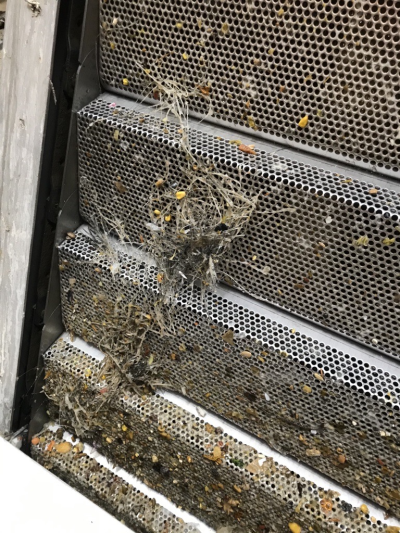Karl King, construction coordinator for this project
Our progress: Cataraqui Bay Wastewater Treatment Plant upgrades
At Utilities Kingston, we focus on providing the residents of Kingston with safe and reliable utility services. In 2016 we embarked on a necessary project to expand and upgrade the Cataraqui Bay Wastewater Treatment Plant. This project will help to increase plant capacity, improve the quality of treated wastewater, and upgrade equipment.
These upgrades are important to meeting population growth projections for Kingston. Our employees are committed to its successful completion.
History

The above aerial was photo taken June 9, 2020.
- The west-end plant was constructed in 1962 and went through its last major upgrade in 2002.
- The current upgrades were identified as a City of Kingston priority in the 2010 Sewage Infrastructure Master Plan.
- The planned project is the largest in the four-year municipal utility capital budgets for 2015-2018, as approved by City Council. It is funded through utility rates and impost funds.
- The upgrade will increase the plant’s capacity from 38,800 to 55,000 cubic meters per day to meet projected population growth.
Did you know?
Work on the project is being sequenced so there will be no disruption to sewer services for our customers.
Our progress
Some recent achievements include the following:
- Dewatering and biosolids storage facility brought online
- Loaded the filter media for the Biological Aerated Filter (BAF) process and brought it online
- Primary clarifier number three and four (with two more to go)
- Workshop building structure
- Equipped the headworks building for screening and grit removal, and brought it online
- Programming the computer systems (PLCs) that monitor and control each instrument and device in the plant
Read our previous update from October 2017.
Get an overview of wastewater treatment from our page on the state-of-the-art and environmentally sound Ravensview Wastewater Treatment Plant.
Dewatering and biosolids storage facility
The dewatering process involves the dewatering of solids (sludge and biosolids) prior to disposal, or prior to further treatment and stabilization. This includes sludge/biosolids conditioning, gravity and mechanical thickening and mechanical dewatering.


A key part of the dewatering process – the centrifuge (blue equipment) uses rotation to separate solids from liquids.
Did you know?
It takes 40 days to consume organics in the sludge digester. A precise temperature and consistent sludge speed are critical for optimum treatment. The facility is slated to generate 2,500 cubic metres of ‘sludge cake’ annually!

Dewatering and biosolids storage facility (left), biosolids ‘cake’ storage (right).
Biological Aerated Filter (BAF) process
The BIOSTYR-DUO® BAF process combines the biological treatment and filtration of wastewater into one system that removes ammonia, along with most dissolved contaminants and solids. This will improve the quality of treated wastewater that is discharged to Lake Ontario in the form of natural resource quality water.

Biological Aerated Filter: BAF process gallery with main air header and influent and air lines to each of the six treatment cells. The inset shows an empty treatment cell with installed process air piping and dome trough covers for media retention in the cell during backwash.
Combining these processes allowed us to repurpose the existing aeration tanks to expand the primary clarifier, for settling out organics and some inorganics. Primary clarifier number four has been completed, a challenging task in terms of connecting the tanks and creating consistent tank elevation.

Primary clarifier number four (shown directly behind trailer).
Screening and grit removal
The new headworks facility houses fine screening and vortex grit removal systems. This important equipment helps to capture suspended rags, grit and other floatables and debris in the raw wastewater that is treated at the plant.
Headworks is the first unit process at the plant and it has a vital role in protecting downstream processes and equipment from damage and clogging. You can do your part when you know what not to flush! Never flush wipes, feminine hygiene products, dental floss, needles, hair, or fats, oils and greases.

Computer control
Our in-house team has been focused on programming the nine programmable logic controllers (PLCs) that control each instrument and device in the plant. To give you an idea of the magnitude of this task: the largest PLC at the plant is programmed with FIFTY THOUSAND lines of code, controlling 325 devices.

Did you know? Our in-house knowledge to customize software for our systems helps us operate efficiently. It also means that when we respond to trouble calls, we know the product and can get it up and running more quickly.
The multi-utility model has allowed us to build an in-house, specialized programming team that is recognized in our industries. Ontario municipalities reach out to learn about our innovations, such as the widely-recognized sewer overflow sensors and custom dashboards at treatment plants. Our programming team works closely with our treatment operators to customize the dashboard that allows them to monitor and control treatment operations.
What’s next?
You can count on us! We will provide another update on the project plan and timelines very soon.
By ensuring the reliability of wastewater services and helping to protect Lake Ontario, this project will benefit the community today and generations to come.
